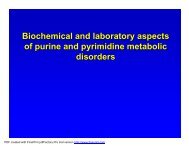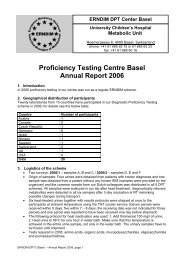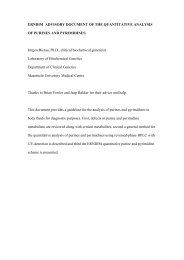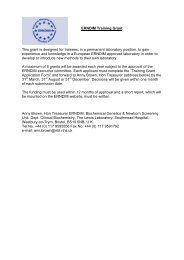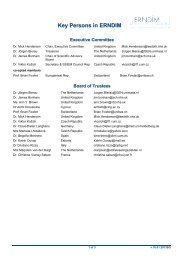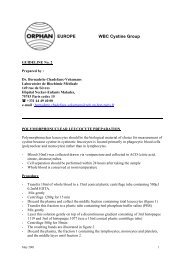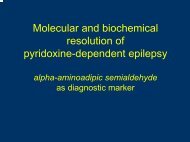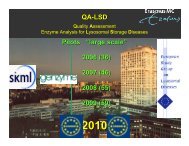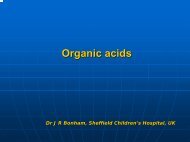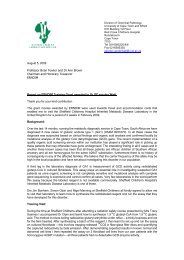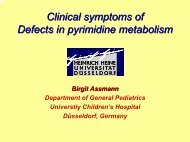A Common Interest in Amino Acids and ERNDIM and ERNDIM
A Common Interest in Amino Acids and ERNDIM and ERNDIM
A Common Interest in Amino Acids and ERNDIM and ERNDIM
Create successful ePaper yourself
Turn your PDF publications into a flip-book with our unique Google optimized e-Paper software.
Dr Mick Henderson<br />
A <strong>Common</strong> <strong>Interest</strong> <strong>in</strong><br />
Biochemical Genetics<br />
St James’s University Hospital, Leeds<br />
Am<strong>in</strong>o <strong>Acids</strong><br />
<strong>and</strong> <strong>ERNDIM</strong>
‘Am<strong>in</strong>o acids’ was the topic of the first<br />
ETAC Academy Course
Pre analytical problems<br />
Material for workshop A<br />
<strong>ERNDIM</strong> tra<strong>in</strong><strong>in</strong>g day<br />
Lisbon 2008
Specimen<br />
• Contam<strong>in</strong>ation<br />
• Delay<br />
Other<br />
• Age<br />
• Infancy/feeds<br />
• Diet / fast<strong>in</strong>g / TPN<br />
ECF, sweat, haemolysis, sk<strong>in</strong><br />
cream, drip fluids.<br />
gln glu<br />
arg orn;<br />
loss of cys, hcys, tryp<br />
e.g. carn; ans; hcit; methyl his<br />
• Drugs<br />
antibiotics, anticonvulsants<br />
• Bacterial metabolism, effects on ur<strong>in</strong>e samples<br />
cys, ser
Homocyst<strong>in</strong>uria Monitor<strong>in</strong>g of Am<strong>in</strong>o <strong>Acids</strong><br />
What to measure<br />
Brian Fowler
Ion Ion-exchange exchange chromatogram Plasma1 Homocyst<strong>in</strong>uria<br />
570<br />
N<strong>in</strong>hydr<strong>in</strong> Response A A570<br />
Methion<strong>in</strong>e<br />
Cys-Hcy<br />
Disulphide<br />
Homocyst<strong>in</strong>e<br />
Bio 03099 (Laharner)<br />
Elution time <strong>in</strong> m<strong>in</strong>utes
Homocyst<strong>in</strong>uria Monitor<strong>in</strong>g of Am<strong>in</strong>o <strong>Acids</strong><br />
Total Homocyste<strong>in</strong>e versus free homocyst<strong>in</strong>e<br />
Moat et al. An Cl<strong>in</strong> Biochem 1999;36: 372-379
Quantitative Am<strong>in</strong>o acid analysis<br />
Report<strong>in</strong>g <strong>and</strong> Interpretation
570<br />
N<strong>in</strong>hydr<strong>in</strong> Response A A570<br />
Ion Ion-exchange exchange chromatogram: St<strong>and</strong>ards<br />
Elution time <strong>in</strong> m<strong>in</strong>utes
Ion Ion-exchange exchange chromatogram Plasma<br />
Citrull<strong>in</strong>aemia
570<br />
N<strong>in</strong>hydr<strong>in</strong> Response A A570<br />
Ion Ion-exchange exchange chromatogram Plasma 5<br />
Arg<strong>in</strong><strong>in</strong>o Arg<strong>in</strong><strong>in</strong>o-succ<strong>in</strong>ic succ<strong>in</strong>ic aciduria<br />
Bio 02046 (Pfeifer J)<br />
Elution time <strong>in</strong> m<strong>in</strong>utes
Ion Ion-exchange exchange chromatogram Ur<strong>in</strong>e<br />
Hawk<strong>in</strong>s<strong>in</strong>uria<br />
Hawk<strong>in</strong>s<strong>in</strong>
Why do cl<strong>in</strong>ical labs measure AA?<br />
• Diagnosis of IEM<br />
• Monitor<strong>in</strong>g diets <strong>in</strong> IEM patients<br />
• General nutritional monitor<strong>in</strong>g<br />
• Research
Automated ion exchange<br />
am<strong>in</strong>o acid analyser <strong>and</strong><br />
plasma chromatogram<br />
A Variety of Techniques<br />
11-Aug-1999, 15:59:41<br />
U35 1 (1.004) 1: Neutral Loss 102ES+<br />
100<br />
%<br />
0<br />
172.2<br />
188.3<br />
203.2 212.4<br />
227.3<br />
222.3<br />
240.4<br />
246.4<br />
260.6<br />
1.66e7<br />
U34 1 (1.004) 1: Neutral Loss 102ES+<br />
100<br />
%<br />
0<br />
172.2<br />
188.3<br />
206.5 212.4<br />
227.3<br />
222.4<br />
240.4<br />
246.5<br />
260.4<br />
1.33e7<br />
U33 1 (1.004) 1: Neutral Loss 102ES+<br />
100<br />
227.3<br />
1.60e7<br />
%<br />
0<br />
172.2 188.3<br />
203.4 212.4 222.3<br />
240.4<br />
246.5<br />
260.4<br />
U32 1 (1.004) 1: Neutral Loss 102ES+<br />
100<br />
227.3<br />
1.63e7<br />
%<br />
0<br />
172.4 188.3<br />
206.2 212.2<br />
222.3<br />
240.4<br />
246.5<br />
260.4<br />
U31 1 (1.004) 1: Neutral Loss 102ES+<br />
100<br />
%<br />
0<br />
172.2<br />
188.2<br />
203.3 212.2<br />
227.3<br />
222.3<br />
240.4<br />
246.4<br />
260.4<br />
1.34e7<br />
U30 1 (1.005) 1: Neutral Loss 102ES+<br />
100<br />
%<br />
0<br />
172.2<br />
188.3<br />
206.3 212.2<br />
227.3<br />
222.3<br />
240.3<br />
246.5 260.4<br />
1.82e7<br />
U29 1 (1.004) 1: Neutral Loss 102ES+<br />
100<br />
%<br />
0<br />
172.2<br />
188.2<br />
203.3 212.2<br />
227.5<br />
222.3<br />
240.4<br />
246.4<br />
260.4<br />
1.46e7<br />
m/z<br />
160 170 180 190 200 210 220 230 240 250 260 270<br />
TLC ur<strong>in</strong>e am<strong>in</strong>o acids,<br />
normal pattern<br />
T<strong>and</strong>em mass spectrometer<br />
<strong>and</strong> bloodspot<br />
chromatograms
Annual workload<br />
summary from the Leeds Lab<br />
• Qualitative am<strong>in</strong>o acids<br />
Ur<strong>in</strong>e TLC 1500<br />
• Quantitative am<strong>in</strong>o acids (ion exchange AAA)<br />
Plasma 2000<br />
Ur<strong>in</strong>e 1000<br />
CSF 60<br />
• Quantitative am<strong>in</strong>o acids (TMS)<br />
Plasma phe/tyr 2400<br />
• Quantitative am<strong>in</strong>o acids screen<strong>in</strong>g (TMS)<br />
Bloodspot phe/tyr/met/leu; 47,000
Dietary Monitor<strong>in</strong>g Examples<br />
Material for workshop C<br />
<strong>ERNDIM</strong> tra<strong>in</strong><strong>in</strong>g day<br />
Lisbon 2008
•<br />
Leu<br />
1800<br />
1600<br />
1400<br />
1200<br />
1000<br />
800<br />
600<br />
400<br />
200<br />
0<br />
Jan<br />
Mar<br />
May<br />
Jul<br />
Sep<br />
Nov<br />
MSUD patients diet history<br />
Jan<br />
Mar<br />
May<br />
Jul<br />
Sep<br />
Time<br />
Nov<br />
Jan<br />
Mar<br />
May<br />
Jul<br />
Sep<br />
Nov<br />
Jan<br />
patient 1<br />
patient 2<br />
action<br />
limits
PKU (umol/mmol creat)<br />
1200<br />
1000<br />
800<br />
600<br />
400<br />
200<br />
0<br />
Aug<br />
Oct<br />
Dec<br />
Feb<br />
Apr<br />
Jun<br />
Aug<br />
PKU patients diet history<br />
Oct<br />
Dec<br />
Feb<br />
Apr<br />
Tim e<br />
Jun<br />
Aug<br />
Oct<br />
Dec<br />
Feb<br />
Apr<br />
Jun<br />
Aug<br />
Oct<br />
Patient 1<br />
Patient 2<br />
diet<br />
targets
Essential am<strong>in</strong>o acids<br />
Histid<strong>in</strong>e, isoleuc<strong>in</strong>e, leuc<strong>in</strong>e, lys<strong>in</strong>e,<br />
methion<strong>in</strong>e, phenylalan<strong>in</strong>e, threon<strong>in</strong>e,<br />
tryptophan, val<strong>in</strong>e<br />
conditionally essential for<br />
neonates:<br />
cyste<strong>in</strong>e, tyros<strong>in</strong>e, taur<strong>in</strong>e,<br />
arg<strong>in</strong><strong>in</strong>e <strong>and</strong> glyc<strong>in</strong>e
Taur<strong>in</strong>e<br />
an honorary am<strong>in</strong>o acid!<br />
HO 3 S<br />
CH 2 CH 2<br />
NH 2
Cats<br />
Essential for<br />
And babies
Cyste<strong>in</strong>e sulf<strong>in</strong>ic acid<br />
decarboxylase
Vital for:<br />
Taur<strong>in</strong>e<br />
• Bile salt formation<br />
• Vision<br />
• Growth<br />
Made from methion<strong>in</strong>e <strong>and</strong><br />
cyste<strong>in</strong>e<br />
Neonates have low CSAD activity<br />
Breast milk is rich <strong>in</strong> taur<strong>in</strong>e<br />
Taur<strong>in</strong>e designated ‘essential nutrient’ by the FDA Expert Panel, 2002
Wharton BA et al Arch Dis Child Fetal Neonatal Ed 2004;89:F497–F498.
Brian was<br />
Council member 1963-68<br />
Secretary 1988-93<br />
Chairman 1994-99<br />
Essential,<br />
Just like the SSIEM!
Sulfite Oxidase<br />
Deficiency<br />
Johnson <strong>and</strong> Wadman,<br />
7th Edition, Scriver, MMBID
Female baby<br />
unrelated parents<br />
term baby, no recorded neonatal problems<br />
severe persistent fitt<strong>in</strong>g from day 2<br />
died at 3 weeks
sulfocyste<strong>in</strong>e<br />
19 mol/L<br />
CSF<br />
Ur<strong>in</strong>e<br />
sulfocyste<strong>in</strong>e<br />
257 mol/L<br />
Plasma<br />
sulfocyste<strong>in</strong>e<br />
40 mol/L
Red Bulluria!
Quality Assurance <strong>and</strong> Education are Vital<br />
All laboratory processes must be subject to<br />
quality control procedures<br />
• Internal QC<br />
real time<br />
enables judgements of acceptability<br />
• External QA<br />
retrospective<br />
<strong>in</strong>dependent <strong>in</strong>dependent verification of performance<br />
Shar<strong>in</strong>g experience of rare materials<br />
who else but <strong>ERNDIM</strong>!



